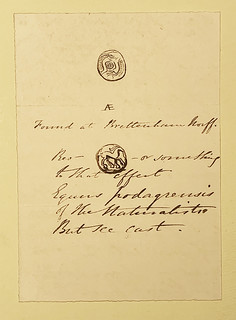
PREV ARTICLE
NEXT ARTICLE
FULL ISSUE
PREV FULL ISSUE
ILLUSTRATOR F. W. FAIRHOLT AND SIR JOHN EVANSBob Van Arsdell writes: "I just published an article on my website that may be interesting to numismatic book collectors and authors. "Sir John Evans' "Coins of the Ancient Britons" was published in 1864 with illustrations by F. W. Fairholt. Recently, Fairholt's copy of the book surfaced in the inventory of an antiquarian bookseller in Detroit, Michigan. The book was a presentation copy from Evans to Fairholt, and has several letters from Evans tipped into the front endpapers. "The letters give an idea of the working relationship between an author and an engraver in the 1850s. The plates in the books are all woodcuts. Evans ran into delays when he was promised an sketch of a coin and it didn't show up on time. Work had to stop on a plate until he could track down the missing sketch or the coin, itself. You couldn't cut-and-paste with woodcuts." Thanks! Here's an excerpt, but see the complete article (and others) online. -Editor Fairholt appears to have pasted a note from Evans with a coin sketch and findspot details on the front pastedown. On the first side of the first free endpaper, he tipped-in a four-page letter from Evans dated 1860, and onto that another two-page letter from the same year. These additions give some idea of the working relationship between Evans and Fairholt. Evans mentions the difficulty of obtaining images of coins. This caused delays in completing the work. Fairholt had to cut the images into wood, so every image had to be secured before a plate could be cut. There was no possibility of inserting a coin after the cutting was done. If the images spilled over onto the next plate, delays in cutting that plate would occur. One can see Evans instructing Fairholt to cut parts of a plate, but then to stop and see if a promised image was forthcoming. It was a far cry from today's electronic methods in which images can easily be moved around, inserted and sized to fit a space. The letters also give some appreciation for the friendship between Evans and Fairholt, with Evans inquiring about Fairholt's health and giving advice about medicines and cures. Fairholt would succumb to tuberculosis in 1866. He did not make any annotations in the book Evans gave him.
(sketch of obverse)
To read the complete article, see:
Bob also passed along these useful articles on woodcuts and wood engraving. Thanks! -Editor

Wayne Homren, Editor The Numismatic Bibliomania Society is a non-profit organization promoting numismatic literature. See our web site at coinbooks.org. To submit items for publication in The E-Sylum, write to the Editor at this address: whomren@gmail.com To subscribe go to: https://my.binhost.com/lists/listinfo/esylum All Rights Reserved. NBS Home Page Contact the NBS webmaster 
|


